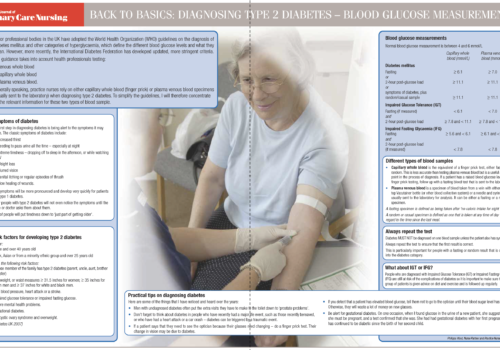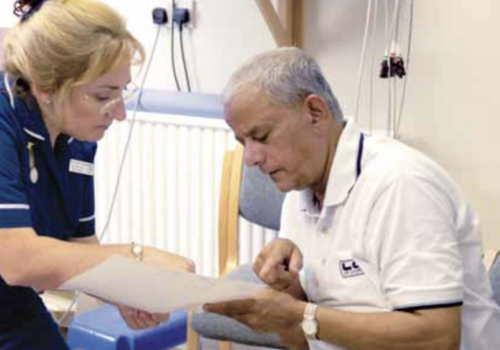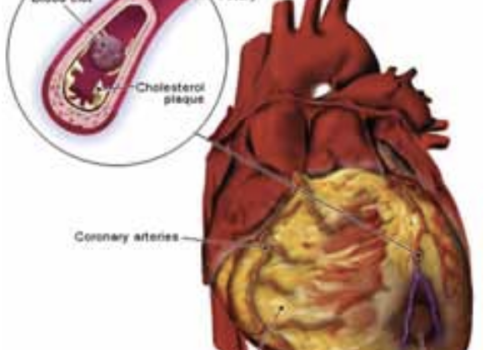We have been out on the road, with six BJPCN roadshows around the UK throughout the last few months. Thank you to the dozens of primary care nurses who attended the workshops and made them such fun, and here is a snapshot of the events for everyone unable to be there.
Editorial
As the daffodils start to bloom and we move into the Spring of 2008, I hope that BJPCN can help you find fresh resolve and inspiration to cope with the challenges facing primary care nursing in the year ahead.
Back to Basics: Diagnosing type 2 diabetes – blood glucose measurements
You and your treatment: starting on warfarin
Exenatide: a new step in type 2 diabetes treatment
Exenatide (Byetta) is the first glucagon-like peptide-1 analogue (GLP-1 analogue) to be approved for the treatment of type 2 diabetes. It is a twice-daily injection, currently prescribable only by consultants, given before breakfast and before the evening meal. The early signs are that this new and different medicine has the potential to be very exciting for both patients and healthcare professionals. Studies show a reduction in HbA1c as well as steady weight loss – every diabetic’s dream! In this article, we look at how exenatide works, where it fits into current practice and the pros and cons of this new preparation.
Acting on the latest nice guidance on secondary prevention of myocardial infarction
The latest National Institute for Health and Clinical Excellence (NICE) guidance on the secondary prevention of myocardial infarction (MI) is designed to help us achieve even more impact in reducing cardiovascular deaths, with updated recommendations on drug therapy and clear advice on diet, physical activity and smoking cessation. This article gives you a summary of the aims of the guidance and highlights issues of particular interest to primary care nurses delivering CVD management in practice.
A spoonful of sugar: helping older patients to take their medicines
As people get older, their use of medications tends to rise and elderly patients often take a variety of medicines for an increasing number of health problems. Four in five people over the age of 75 years take at least one prescribed medication, while 36% are taking four or more, according to the 1998 Health Survey for England. How can we help our older patients to take their medicines, optimising convenience and minimising risks of non-compliance and sideeffects?
Primary angioplasty: the best way to unblock arteries after a heart attack?
Primary angioplasty is now recognised as the best treatment for clearing a blocked coronary artery after an ST segment elevation myocardial infarction (STEMI) and increasing numbers of patients will undergo this procedure as it becomes more available. In this article, we explore what is involved in primary angioplasty, what you need to tell to your patients and how to care for them after this procedure.
Helping patients to lose weight: best practice for primary care
Obesity poses a major threat to the nation’s health and a national strategy is required to stem the rising prevalence, decrease the morbidity and mortality from associated conditions, and reduce pressure on the National Health Service. Primary healthcare staff will be at the centre of any such approach. Practice nurse-led lifestyle clinics have demonstrated that clinically beneficial weight loss can be achieved with a structured approach to weight management. In this article, we explore the impact of obesity and best practice strategies to help patients lose weight.
Optimising the prevention and management of obesity: putting NICE guidance into practice
Obesity is a rapidly growing problem in the UK. Department of Health statistics show that the prevalence of obesity in children under 11 years of age rose from 9.9% in 1995 to 13.7% in 2003, and in adults obesity prevalence has trebled since the 1980s, with more than 50%, (almost 24 million adults), now being classed as overweight or obese. In the article, we review the latest guidance from the National Institute for Health and Clinical Excellence (NICE) on how to prevent and manage obesity in practice.
Mending the growing problem of childhood obesity
There is no argument about the fact that childhood obesity in the UK is a serious problem. According to the Department of Health, childhood obesity affected 14.3% of 2-10 year olds in England in 2004. This was almost 5% more compared to the 1995 figures, and the estimated prevalence for 2010 is 20% if nothing is done, meaning that one million children will be obese. What can we do to reverse this growing epidemic of childhood obesity?
Phase II cardiac rehabilitation in primary care
Cardiac rehabilitation is an aspect of Coronary Heart Disease (CHD) management that many primary care health professionals admit to knowing relatively little about. In this article, we explore the central role of primary care in cardiac rehabilitation.























